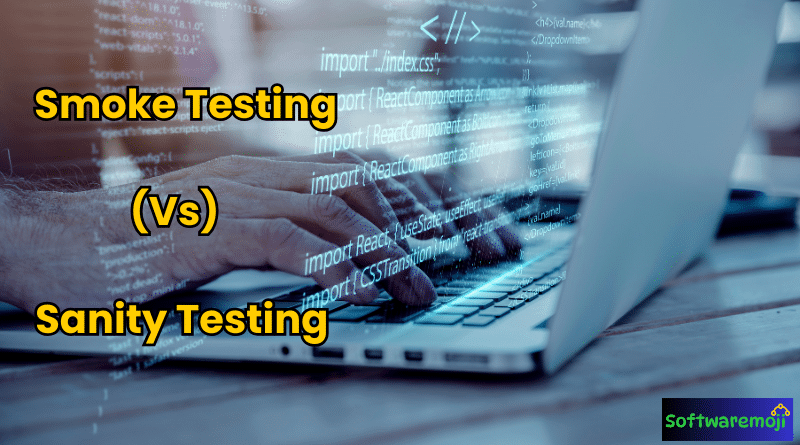
Smoke and Sanity Testing:
🏹What is Smoke Testing?
Smoke Testing is a preliminary software testing process conducted to verify whether the critical functionalities of an application are working correctly after a new build is released. It is performed before conducting more rigorous functional or regression testing. The main purpose of smoke testing is to identify major defects early, ensuring that the software is stable enough for further testing.
🏹Key Characteristics of Smoke Testing:
- Ensures that the application’s essential functionalities work properly.
- Conducted on a new software build before in-depth testing.
- Helps in identifying critical issues early.
- Saves time by preventing detailed testing of an unstable application.
- Can be automated or executed manually.
- Considered a subset of Acceptance Testing.
- Documented and scripted for consistency.
- Often referred to as Build Verification Testing (BVT).
🏹Example of Smoke Testing:
Suppose a new version of an e-commerce application is built. Smoke testing would involve checking whether:
- The application launches successfully.
- The user can log in and log out.
- The homepage loads correctly.
- The product search functionality works.
If any of these critical functionalities fail, the build is rejected for further testing.
🏹What is Sanity Testing?
Sanity Testing is a focused testing approach conducted on a software build that has undergone minor changes, such as bug fixes or small enhancements. It ensures that the specific functionalities that were modified are working as expected and that no new defects were introduced.
🏹Key Characteristics of Sanity Testing:
- Ensures that recent changes (bug fixes or enhancements) work as intended.
- Conducted after receiving a stable build with minor updates.
- Unscripted and exploratory in nature.
- Focuses only on the modified functionalities.
- Helps in verifying the logical correctness of recent updates.
- Considered a subset of Regression Testing.
- Quick and efficient testing to approve the build for further testing.
🏹Example of Sanity Testing:
If a bug related to the checkout process in an e-commerce app is fixed, sanity testing would involve:
- Checking whether the checkout process now works correctly.
- Ensuring that the fix does not break any related functionalities.
- Verifying that no new issues have been introduced in the process.
If the sanity test fails, the build is rejected to prevent unnecessary efforts in extensive testing.
🏹Smoke Testing vs. Sanity Testing: Key Differences:-
| Feature | Smoke Testing | Sanity Testing |
|---|---|---|
| Purpose | Verifies the stability of the application | Verifies rationality of recent changes |
| Scope | Covers the entire system | Focuses on specific modules or functionalities |
| When it is Performed? | After a new build is released | After minor bug fixes or enhancements |
| Performed by | Developers or Testers | Testers |
| Documentation | Well-documented and scripted | Usually undocumented and unscripted |
| Testing Approach | Broad, high-level checks | Narrow, focused checks |
| Relation to Other Testing Types | Subset of Acceptance Testing | Subset of Regression Testing |
| Examples | Checking login, homepage, and major functions | Checking whether a bug fix in the checkout process works |
🏹Best Practices for Smoke and Sanity Testing:
🏹Best Practices for Smoke Testing:
- Automate Repetitive Tests: Use automation tools to run smoke tests efficiently.
- Define Critical Test Cases: Focus on key functionalities that determine the software’s stability.
- Execute After Every Build: Run smoke tests after every new build to catch issues early.
- Document the Process: Maintain test cases and execution logs for reference.
- Use Continuous Integration (CI): Integrate smoke tests with CI/CD pipelines for fast feedback.
🏹Best Practices for Sanity Testing:
- Prioritize Recent Changes: Focus only on the modified features or bug fixes.
- Perform Quick Exploratory Testing: Do not follow exhaustive test cases; instead, check for logical correctness.
- Ensure No Side Effects: Verify that the changes do not impact other modules.
- Combine with Smoke Testing: To speed up the process, sanity tests can be combined with smoke tests when required.
- Execute Before Regression Testing: Conduct sanity testing before a full regression test to ensure a stable test environment.
Previous Post: Integration Testing:-
🏹Conclusion:
Both Smoke Testing and Sanity Testing play crucial roles in software quality assurance. While smoke testing ensures that the overall system is stable, sanity testing validates specific changes to confirm their correctness. Implementing both testing methodologies effectively can save time, reduce costs, and improve the reliability of software applications.
